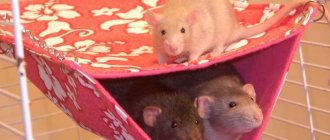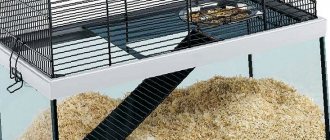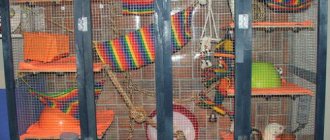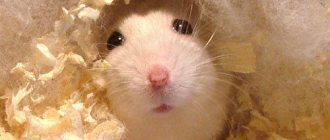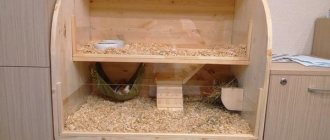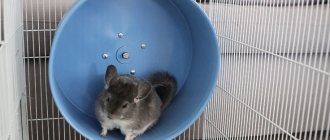- home
- Rat
- Care
06/08/2019 All pets, including decorative rodents such as rats, need a cozy home. If the owner wants his pet to feel comfortable, he must take care of a reliable and comfortable shelter. This article is about what a house for a rat should be like, and how to make it with your own hands.
Why does a rat need a house?
Decorative rats spend most of their free time outside the house. However, the animal should still have a place for privacy. Moreover, when several pets live in a cage at once, the house should be spacious. Fluffies usually spend time in it in the following situations:
- Unfavorable external conditions . For example, low air temperature, scorching sun or drafts. Inside, the pet can easily hide from irritating factors and wait for more favorable conditions to arrive. Some rodents specially insulate their houses with paper napkins, small rags and generally anything else that gets in their way.
- Stress . Decorative rats are quite shy and difficult to adapt to changing conditions. For example, moving (even to another room), visiting strangers, moving in with a new cagemate. Fluffy just needs a place of solitude, where he can calm down a little and comprehend the events that are happening.
- Deterioration in health . When a pet is weakened, it does not show much activity and prefers to simply relax, lying in a secluded place. This is exactly the place the house is. As soon as the fluffy gets better, he will leave his shelter.
It is worth noting that under no circumstances should you try to force a rat out of the house. The animal rarely enters the shelter unless absolutely necessary. Therefore, if the pet decides to retire, it is not recommended to disturb its peace.
What is it needed for
Does a rat really need a house? Experts insist that the animal must have its own secluded corner. Let's try to figure out the reasons.
First of all, it is necessary to note the stressful situations that can happen to an animal due to many factors. A stranger, loud noises, sudden movements - all this can frighten the animal, and it will want to hide.
In the absence of such an opportunity, even tame rats can experience attacks of aggression and panic, which in severe cases lead to health problems.
While providing comfortable conditions for a pet, owners need to take care that the cage is not exposed to drafts. Rats can be very sensitive to them and often get colds. A house with windproof walls will allow you to hide inside and not get sick. Also, in an insulated house you can easily hide from the cold, even in an apartment where, for some reason, the temperature is quite low. If direct sunlight hits the cage, rats, on the contrary, can hide in a shelter from the heat.
The rat feels safe in the shelter . This is especially important if the animal is not feeling well. Calmer males feel much more comfortable without a house, while girls, on the contrary, need protection and a secluded corner.
How to choose a house
When choosing a house for a rat, you must first focus on the size of the pet. Some rodent owners purchase compact designs designed for hamsters at pet stores. However, rats are much larger. The size of an adult, excluding the tail, can reach 25 cm. Even when buying a small rat, you need to keep in mind that it will soon increase several times in size.
Also, the house must have 2 entrances. This is necessary so that the rat does not feel constrained or limited. Moreover, it’s more convenient, you don’t need to turn around once again: the pet entered on one side, and came out on the other. The openings should also be spacious so that well-fed fluffies or, for example, pregnant females do not get stuck in them.
One of the decisive parameters when choosing a suitable house for rats is the material of manufacture - each has its own pros and cons:
- Tree . Wooden houses are rightfully considered the most environmentally friendly. They do not emit toxic substances, smell pleasant and create a cozy atmosphere in the cage. However, wood has two significant drawbacks. Firstly, the material absorbs odors well, and after a while an unpleasant odor will begin to emanate from the rat shelter, to put it mildly. Secondly, the strong teeth of rodents will deal with a wooden house in just a few days.
- Plastic . It is considered the most optimal option. The material is light and absolutely safe, does not absorb urine or odors, and is easy to clean. The only drawback of plastic houses is that they create noise if the animal inside decides to frolic.
- Ceramics . The material has similar advantages to plastic. In addition, a rat can hide in a ceramic house in the summer heat. But such products have one big drawback - they are quite fragile and can break at the slightest fall. In addition to the fact that you will have to buy a new house, you will need to take care of the pet’s safety and carry out a general cleaning of the cage, because the animal can be injured by a small fragment that has rolled into a secluded place.
- Textile . Rag houses look very original, and besides, they can be hung from the ceiling of the cage to save space. Also, houses made of fabric are very soft and cozy, perfectly warming rodents in winter. Despite the fact that the fabric perfectly absorbs urine, the design can be washed at any time. But it’s unlikely that anything will save such a flimsy structure from damage by powerful cutters.
- Plant materials - twigs, bark, hay, compressed grass. A house made from plants can only be considered as a temporary home. After all, all the constituent elements of plant structures are edible for rats. And the pet will not miss the opportunity to feast on it once again. Therefore, it is better to buy houses made from plants just to pamper your pet a little.
Also, when choosing a house for a rat, it is necessary to take into account the design of the structure. Currently, houses for rodents are sold in a variety of shapes - round, square, rectangular, triangular, two- and three-room. The same can be said about the color palette - designs of any colors are available in the pet store, even acidic ones. However, it is better not to buy houses that are too bright for rats - rodents prefer calmer colors.
Accessories for the cage
When caring, you need to think about the physical and mental health of your pets.
Rats are intellectually developed creatures. They need toys, hammocks to sleep in, places to wait out danger, and materials to sharpen their teeth. Toys and objects for incisors need to be changed frequently, otherwise your pets will get bored with them.
When choosing a wheel-style treadmill, make sure it is large enough for your rat, but does not take up too much space in the cage. Buying a cardio wheel is not a requirement. As rodents grow up, they lose interest in running on wheels.
There should be a solid and heavy container for food in the cage, and a drinking bowl with at least 0.5 liters of water should be hung between the bars.
What can be used as a house
Many experienced breeders of decorative rats advise you to take a closer look at some elements of your home interior. Among them you can find things that could be considered a house for a pet. For example:
- Flower pots (or ice cream bucket) . The most optimal would be a medium-sized container, preferably made of plastic. All you need to do is simply lay the pot on its side and secure it to the bottom of the cage so that it does not roll around. For convenience, you can simply cut off the sidewall on one side. Then it's up to the pet - he will quickly bring filler and food supplies into his new shelter.
- Food containers . Rats do not like bright light and also prefer to remain unnoticed in their hiding place. Therefore, it is recommended to use only containers made of opaque plastic as the basis for a rat house. All you need to do is simply cut a round hole on the side for the pet to enter and exit.
- Cardboard boxes are the easiest option. Its advantage is absolute safety and scope for the owner’s imagination. Such a house can be covered with colored paper, a pattern can be applied to the walls, and it can be decorated with decorative elements. However, such a structure will emit an unpleasant odor, and will not last long - the rat will quickly gnaw through it with its sharp teeth.
- An unnecessary shade from a chandelier , preferably made of frosted glass. You just need to put the device on its side and wait for the pet to settle into its new house.
- Spacious dollhouse . Usually the inside of doll houses is very interesting - there are ladders, doors, windows, and other interior elements. The little explorer will love this unusual shelter. After all, you can not only relax in it, but also have plenty of frolic.
If children live in the house, you can borrow a few Lego pieces from the kids to make a rat house. For variety, such a design can be periodically transformed.
Fans of environmentally friendly products will love the rat house made from coconut . To do this, you will need to make a hole in the peel, pour out the milk and completely remove the pulp. After that, send the resulting hard shell to dry in the sun. After a couple of days, the house can be secured in the cage. However, this design has a short shelf life. Naturally, the rat will try such an unusual and delicious-smelling house.
An option for real needlewomen - a closed knitted hammock
Knitted houses for rats, created by yourself, are an option that will allow you to create colorful and comfortable housing for your pet. A knitted house is called a hammock. The hammock can be closed or open.
The principle of creating a closed hammock:
- The easiest way to create a design is with a hook. It is advisable to use acrylic threads for knitting.
- Knitting starts from the bottom. You can make the bottom double and put a piece of plywood in the resulting pocket.
- It is possible to knit in the round or knit individual parts and then sew them. The simplest option is circular knitting.
- It is worth casting on five air loops and closing them in a circle. Next, knit several rows adding 1 loop to each row. The number of such rows is determined by the desired size. This knitting will allow you to form the floor of the house.
- After making the bottom of the house, you can start knitting the walls. Rows are knitted without additions. Their number will determine the lifting height for the move.
- You need to count 10 loops and do not knit them until the opening is formed.
- Then the unknitted loops are closed using a chain of air loops.
- The roof is knitted in the same way as the floor. Only instead of adding loops in each row, a decrease is made.
In order not to think about how to shape the product using various frames, you can simply hang the hammock at several points. The house will stretch and take on the desired shape.
How to make a house with your own hands
Particularly caring owners of decorative rats prefer to make houses for their pets exclusively with their own hands. At first glance, such a task seems difficult. However, in reality everything is not so scary. Consider, for example, step-by-step instructions for making a rat house from plywood:
- Drawing up a drawing . At this stage, you will need to transfer the design of the future house onto paper with the smallest details, respecting the scale and taking into account the parameters of the cell. The drawing will allow you to accurately determine the amount of material required, and will also help you not to get confused about the number and size of parts.
- Applying markings on plywood using a felt-tip pen or marker.
- Cutting out the planned parts with a hacksaw . In this case, you will need to make two openings on opposite walls of the house. Windows and doors with a diameter of 5-6 cm are considered optimal.
Fastening the cut parts with self-tapping screws. You can use construction adhesive. But in this case, you will have to postpone moving in for a couple of days, since adhesives are toxic and release harmful substances into the air. It is also not recommended to varnish the house, since it not only releases toxins, but can also cause severe allergies in rodents.
Experienced rat breeders advise that when making a house from wood or plywood, make it without a bottom. This design is more hygienic - waste will fall directly into the pan, and there will be no unpleasant odor coming from the house.
Knowing everything about houses for rats: how to choose and how to make them yourself, any owner of a small animal will be able to provide comfort and coziness to their pet. And the fluffy, in turn, will not forget to say “thank you” to the owner in the form of affection and selfless love.
What to equip
Rats are very energetic animals; structures for climbing and other active games must be placed in the house: ladders, shelves, tunnels. Unlike their other rodent brethren, they are indifferent to the spinning wheel and are not worth purchasing.
First of all, build a “nest”; an ordinary cardboard box with a drilled hole will do for its manufacture. In such a shelter, your tailed friend will feel comfortable and safe, relax and sleep. Place paper and small rags on the bottom; they will be used for home improvement. If you want to please your pet, buy a nest in the form of a ball, hanging basket or hammock; rats love them very much.
Safety
The wire floor can damage your pet's paws. In addition, contact with iron can cause a rat to develop an infection on its paws. It will be very difficult to get rid of the fungus.
The cage for a decorative rat should be spacious.
Fillers with pine flavors are not suitable for rats; they negatively affect the condition of the animal’s fur. In addition, they cause respiratory pathologies.
Options for designs and materials
Pet stores offer a variety of designs and shapes, as well as manufacturing materials. You can choose simple, rectangular ones with flat roofs, or fancy shapes in the form of a castle or mushroom, in beautiful colors.
Made of plastic
Plastic shelters are considered convenient and practical. They are easy to wash and attach to the bars of the cage. Prices for such designs are affordable. But in such a shelter in the summer the rodent will be uncomfortable, since the walls do not “breathe”, it will be stuffy inside. Windows partly solve the problem.
Wooden
Rodents really like wooden structures. They quickly adapt them not only for relaxation, but also in order to sharpen their constantly growing teeth. When a rat is not litter box trained, the house will quickly become dirty and smell bad. It will have to be changed after 3 - 4 months. Even if the rodent is clean, during the same period the house will be “gnawed” beyond recognition.
Basket houses
Lightweight shelters for rodents in the form of baskets made from tree bark, twigs and straw are environmentally friendly and aesthetically pleasing. Animals really like these designs. However, they fail very quickly thanks to sharp teeth and rat curiosity.
Made of ceramics
Ceramic products are environmentally friendly, hygienic structures. They are cool in the summer and look great. Rodents will not be able to sharpen their teeth on them. But they can accidentally break them. This must be monitored carefully. Broken shards are dangerous.
Results
When the cage is small, this is not a reason not to give your pet a house. You can also attach it outside. They remove one of the doors, and attach the house to this place close to the wall. The second option is to hang a hammock. It takes up very little space.
When the rat is completely tame, the cage does not close; the house can simply be placed next to it. The important thing for a pet is that it has its own shelter.
Decorative rats have captured the hearts of many pet lovers. These are very smart, inquisitive animals with their own character and habits, and the owners try to make their maintenance as comfortable as possible. One of the conditions for this is that the animal has its own house. How to choose the right one or make it yourself – we’ll talk in our article.

